翻译理论与实践 第十九节
- 格式:ppt
- 大小:195.50 KB
- 文档页数:6
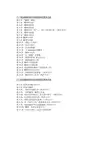
一.英汉翻译理论与实践课程之教案目录第1讲“翻译”溯源第2讲翻译的本质第3讲翻译的标准第4讲翻译面面观第5讲翻译必有“失”/ 失于此而得于彼(两讲合并)第6讲翻译与联想第7讲翻译与语法第8讲翻译与语体第9讲翻译与语篇第10讲英汉十大差异第11讲形合与意合第12讲代词的困惑第13讲Connotation的翻译第14讲翻译与词典第15讲以“模糊”求精确第16讲落笔知轻重译文讲分寸第17讲翻译最难是口吻第18讲翻译与形象思维第19讲翻译与灵感思维第20讲英语修辞的翻译(包括连接三讲)第21讲翻译中的文化冲击第22讲思维是语言的脊梁(两讲合并)第23讲翻译美学之思考(两讲合并)二.汉英翻译理论与实践课程之教案目录第1讲汉译英呼唤文字功力第2讲语篇与翻译第3讲:英汉语美感比读(两讲合并)第4讲:理性概译:翻译之坦途第5讲:英语句式的亮点:非人称主语句(两讲合并)第6讲:汉译英有用的句型(两讲合并)第7讲:类析汉译英常见拙译(三讲合并)第8讲:从“湖光山色”的英译说开去(两讲合并)第9讲:Denotation和Connotation(两讲合并)第10讲:翻译,你的本质是什么?第11讲:归化与异化----汉语习语的英译一.英汉翻译理论与实践课程之练习第1讲“翻译”溯源试将下列文字译成汉语:1/ Translation consists in reproducing in the receptor language the closest natural equivalent of the source language, first in terms of meaning and secondly in terms of style. (Eugene A. Nida & Charles R. Taber: The Theory and Practice of Translation, 1969)2/ Translation may be defined as follows:The replacement of textual material in one language (SL) by equivalent textual material in another language (TL)3/ A translation should give a complete transcript of the ideas of the original work. The style and manner of writing should be of the same character as that of the original. A translation should have all the ease of the original composition. (A. F. Tytler: Essay on the Principles of Translation. 1791)参考译文1/ 所谓翻译,是在译语中用最切近的自然的对等语再现原语的信息,首先是意义,其次是文体。
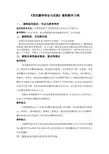
《英汉翻译理论与实践》课程教学大纲一、课程适用层次、专业与参考学时适用层次及专业:本课程适用于英语系英语专业本科三年级学生。
参考学时:共60学时,其中理论教学和实践教学各半,为30学时。
二、课程性质、目的和任务本课程是为我院英语专业本科学生开设的一门专业必修课。
课程的目的和任务是通过该课程的教学和实践使学生对翻译的定义、翻译标准和原则、翻译技巧等理论有一定认识和了解并通过课堂实践活动对所学理论知识加以巩固提高,为学生在大学四年级参加专业八级的考试,为毕业后进去社会,踏上工作岗位,不断在工作中积累经验和提高自己的翻译能力奠定坚实的基础。
三、课程内容的基本要求、重点和难点基本要求:本课程要求学生通过理论学习和实践系统的掌握翻译基本的理论知识和技巧。
要求学生对翻译的标准,英汉翻译的原则、方法等有所了解,并掌握一些基本的翻译方法和技巧,如英汉翻译中的选词法、转换法、拆译法、增词减词法、省略法、重复法、被动语态的翻译以及长句的翻译等技巧。
掌握英汉翻译常用的翻译方法和技巧是本课程教学的重点,需要学生不仅在理论上对这些方法和技巧有所认识和了解,更重要的是能在翻译实践中运用自如,真正把书本知识变成自己在翻译实践中的有力工具。
实践在本课程教学中占有非常重要的地位和作用,应让学生自己动手练习,在练习中掌握相关翻译知识和技巧。
教学重点:本课程的重点在于各种英汉翻译技巧的练习和掌握,如英汉翻译中的转换法、拆译法、增词减词法、省略法、重复法、被动语态的翻译以及长句的翻译,翻译中的各种句法处理、四字结构的翻译等技巧。
教学难点:本课程的难点在于如何通过理论知识的讲解和实践练习让学生真正的掌握英汉翻译中的各种技巧并灵活应用,达到英语专业八级的翻译水平并尝试进行文学作品翻译。
四、课程总体安排及各部分学时分配总体安排:理论教学30学时,实践教学30学时。
课程主要教学内容及学时分配分别见下表:五、课程教学内容和教学基本要求第一章翻译,翻译的标准、过程以及对译者的要求本章理论教学2学时,翻译的标准与过程1学时,翻译对译者的要求1学时,实习教学0学时,共2学时。
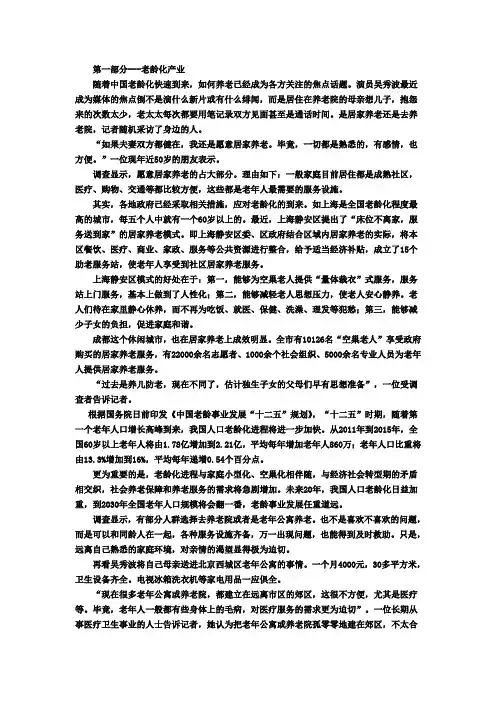
第一部分---老龄化产业随着中国老龄化快速到来,如何养老已经成为各方关注的焦点话题。
演员吴秀波最近成为媒体的焦点倒不是演什么新片或有什么绯闻,而是居住在养老院的母亲想儿子,抱怨来的次数太少,老太太每次都要用笔记录双方见面甚至是通话时间。
是居家养老还是去养老院,记者随机采访了身边的人。
“如果夫妻双方都健在,我还是愿意居家养老。
毕竟,一切都是熟悉的,有感情,也方便。
”一位现年近50岁的朋友表示。
调查显示,愿意居家养老的占大部分。
理由如下:一般家庭目前居住都是成熟社区,医疗、购物、交通等都比较方便,这些都是老年人最需要的服务设施。
其实,各地政府已经采取相关措施,应对老龄化的到来。
如上海是全国老龄化程度最高的城市,每五个人中就有一个60岁以上的。
最近,上海静安区提出了“床位不离家,服务送到家”的居家养老模式。
即上海静安区委、区政府结合区域内居家养老的实际,将本区餐饮、医疗、商业、家政、服务等公共资源进行整合,给予适当经济补贴,成立了15个助老服务站,使老年人享受到社区居家养老服务。
上海静安区模式的好处在于:第一,能够为空巢老人提供“量体裁衣”式服务,服务站上门服务,基本上做到了人性化;第二,能够减轻老人思想压力,使老人安心静养。
老人们待在家里静心休养,而不再为吃饭、就医、保健、洗澡、理发等犯愁;第三,能够减少子女的负担,促进家庭和谐。
成都这个休闲城市,也在居家养老上成效明显。
全市有10126名“空巢老人”享受政府购买的居家养老服务,有22000余名志愿者、1000余个社会组织、5000余名专业人员为老年人提供居家养老服务。
“过去是养儿防老,现在不同了,估计独生子女的父母们早有思想准备”,一位受调查者告诉记者。
根据国务院日前印发《中国老龄事业发展“十二五”规划》,“十二五”时期,随着第一个老年人口增长高峰到来,我国人口老龄化进程将进一步加快。
从2011年到2015年,全国60岁以上老年人将由1.78亿增加到2.21亿,平均每年增加老年人860万;老年人口比重将由13.3%增加到16%,平均每年递增0.54个百分点。
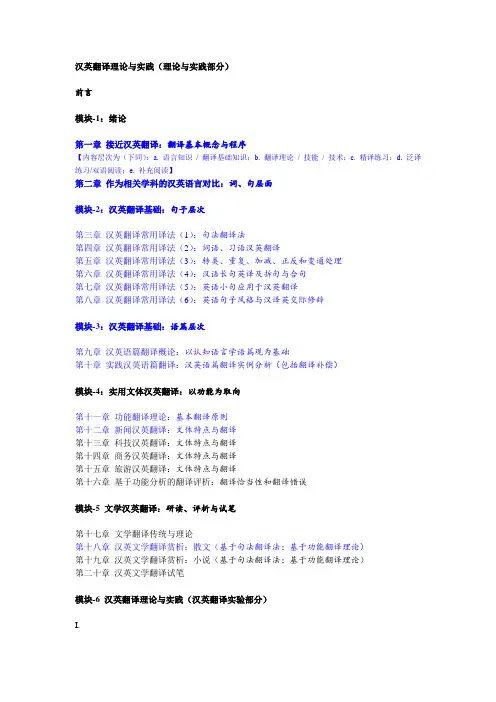
汉英翻译理论与实践(理论与实践部分)前言模块-1:绪论第一章接近汉英翻译:翻译基本概念与程序【内容层次为(下同):a. 语言知识/ 翻译基础知识;b. 翻译理论/ 技能/ 技术;c. 精译练习;d. 泛译练习/双语阅读;e. 补充阅读】第二章作为相关学科的汉英语言对比:词、句层面模块-2:汉英翻译基础:句子层次第三章汉英翻译常用译法(1):句法翻译法第四章汉英翻译常用译法(2):词语、习语汉英翻译第五章汉英翻译常用译法(3):转类、重复、加减、正反和变通处理第六章汉英翻译常用译法(4):汉语长句英译及拆句与合句第七章汉英翻译常用译法(5):英语小句应用于汉英翻译第八章汉英翻译常用译法(6):英语句子风格与汉译英交际修辞模块-3:汉英翻译基础:语篇层次第九章汉英语篇翻译概论:以认知语言学语篇观为基础第十章实践汉英语篇翻译:汉英语篇翻译实例分析(包括翻译补偿)模块-4:实用文体汉英翻译:以功能为取向第十一章功能翻译理论:基本翻译原则第十二章新闻汉英翻译:文体特点与翻译第十三章科技汉英翻译:文体特点与翻译第十四章商务汉英翻译:文体特点与翻译第十五章旅游汉英翻译:文体特点与翻译第十六章基于功能分析的翻译评析:翻译恰当性和翻译错误模块-5 文学汉英翻译:研读、评析与试笔第十七章文学翻译传统与理论第十八章汉英文学翻译赏析:散文(基于句法翻译法;基于功能翻译理论)第十九章汉英文学翻译赏析:小说(基于句法翻译法;基于功能翻译理论)第二十章汉英文学翻译试笔模块-6 汉英翻译理论与实践(汉英翻译实验部分)I.1、翻译技术与资源【实验指导书按单元编写,含实验目的及翻译环境条件、实验构成/过程、实验报告。
】2、汉英翻译基本技巧(1)3、汉英翻译基本技巧(2)4、汉英翻译基本技巧(3)5、汉英翻译基本技巧(4)6、汉英语篇翻译II.1、新闻汉英翻译2、科技汉英翻译3、商务汉英翻译4、旅游汉英翻译5、文学汉英翻译参考译文参考文献。
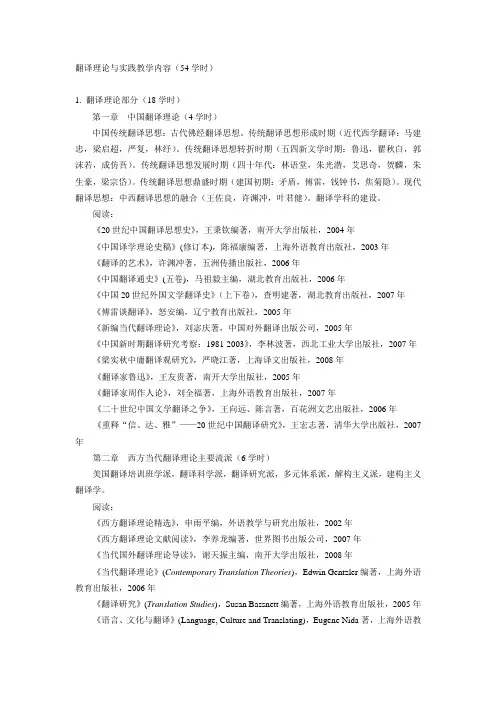
翻译理论与实践教学内容(54学时)1. 翻译理论部分(18学时)第一章中国翻译理论(4学时)中国传统翻译思想:古代佛经翻译思想。
传统翻译思想形成时期(近代西学翻译:马建忠,梁启超,严复,林纾)。
传统翻译思想转折时期(五四新文学时期:鲁迅,瞿秋白,郭沫若,成仿吾)。
传统翻译思想发展时期(四十年代:林语堂,朱光潜,艾思奇,贺麟,朱生豪,梁宗岱)。
传统翻译思想鼎盛时期(建国初期:矛盾,傅雷,钱钟书,焦菊隐)。
现代翻译思想:中西翻译思想的融合(王佐良,许渊冲,叶君健)。
翻译学科的建设。
阅读:《20世纪中国翻译思想史》,王秉钦编著,南开大学出版社,2004年《中国译学理论史稿》(修订本),陈福康编著,上海外语教育出版社,2003年《翻译的艺术》,许渊冲著,五洲传播出版社,2006年《中国翻译通史》(五卷),马祖毅主编,湖北教育出版社,2006年《中国20世纪外国文学翻译史》(上下卷),查明建著,湖北教育出版社,2007年《傅雷谈翻译》,怒安编,辽宁教育出版社,2005年《新编当代翻译理论》,刘宓庆著,中国对外翻译出版公司,2005年《中国新时期翻译研究考察:1981-2003》,李林波著,西北工业大学出版社,2007年《梁实秋中庸翻译观研究》,严晓江著,上海译文出版社,2008年《翻译家鲁迅》,王友贵著,南开大学出版社,2005年《翻译家周作人论》,刘全福著,上海外语教育出版社,2007年《二十世纪中国文学翻译之争》,王向远、陈言著,百花洲文艺出版社,2006年《重释“信、达、雅”——20世纪中国翻译研究》,王宏志著,清华大学出版社,2007年第二章西方当代翻译理论主要流派(6学时)美国翻译培训班学派,翻译科学派,翻译研究派,多元体系派,解构主义派,建构主义翻译学。
阅读:《西方翻译理论精选》,申雨平编,外语教学与研究出版社,2002年《西方翻译理论文献阅读》,李养龙编著,世界图书出版公司,2007年《当代国外翻译理论导读》,谢天振主编,南开大学出版社,2008年《当代翻译理论》(Contemporary Translation Theories),Edwin Gentzler编著,上海外语教育出版社,2006年《翻译研究》(Translation Studies),Susan Bassnett编著,上海外语教育出版社,2005年《语言、文化与翻译》(Language, Culture and Translating),Eugene Nida著,上海外语教育出版社,1993年《翻译学——一个建构主义的视角》,吕俊、侯向群著,上海外语教育出版社,2006年《西方翻译简史》,谭载喜编著,商务印书馆,2004年《西方翻译研究方法论:70年代以后》,李和庆、黄皓、薄振杰编著,北京大学出版社,2005年《当代美国翻译理论》,郭建中编著,湖北教育出版社,2000年《当代英国翻译理论》,廖七一编著,湖北教育出版社,2001年《西方译论研究》,刘重德著,中国对外翻译出版公司,2003年《奈达翻译理论研究》,马会娟著,外语教学与研究出版社,2003年《新编奈达论翻译》,谭载喜编著,中国对外翻译出版公司,1999年第三章翻译方法(2学时)词对词翻译,直译,意译,歪译,转译,交际翻译。
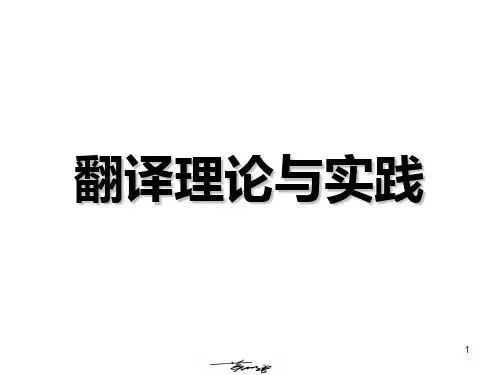
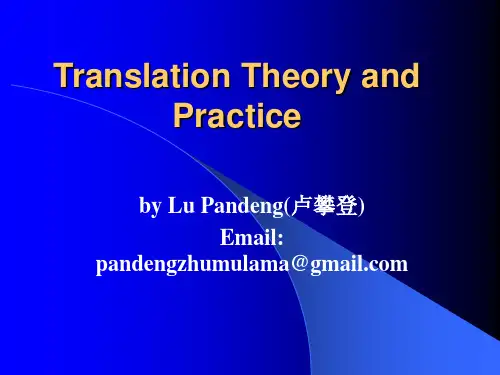
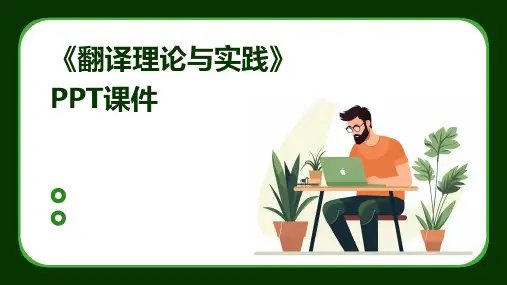
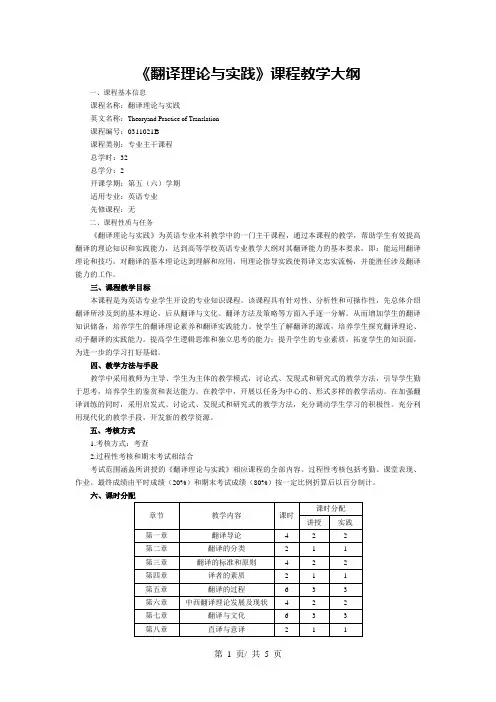
《翻译理论与实践》课程教学大纲一、课程基本信息课程名称:翻译理论与实践英文名称:Theoryand Practice of Translation课程编号:0311021B课程类别:专业主干课程总学时:32总学分:2开课学期:第五(六)学期适用专业:英语专业先修课程:无二、课程性质与任务《翻译理论与实践》为英语专业本科教学中的一门主干课程,通过本课程的教学,帮助学生有效提高翻译的理论知识和实践能力,达到高等学校英语专业教学大纲对其翻译能力的基本要求,即:能运用翻译理论和技巧,对翻译的基本理论达到理解和应用,用理论指导实践使得译文忠实流畅,并能胜任涉及翻译能力的工作。
三、课程教学目标本课程是为英语专业学生开设的专业知识课程。
该课程具有针对性、分析性和可操作性,先总体介绍翻译所涉及到的基本理论,后从翻译与文化、翻译方法及策略等方面入手逐一分解。
从而增加学生的翻译知识储备,培养学生的翻译理论素养和翻译实践能力。
使学生了解翻译的源流,培养学生探究翻译理论、动手翻译的实践能力。
提高学生逻辑思维和独立思考的能力;提升学生的专业素质,拓宽学生的知识面,为进一步的学习打好基础。
四、教学方法与手段教学中采用教师为主导、学生为主体的教学模式,讨论式、发现式和研究式的教学方法,引导学生勤于思考,培养学生的鉴赏和表达能力。
在教学中,开展以任务为中心的、形式多样的教学活动。
在加强翻译训练的同时,采用启发式、讨论式、发现式和研究式的教学方法,充分调动学生学习的积极性。
充分利用现代化的教学手段,开发新的教学资源。
五、考核方式1.考核方式:考查2.过程性考核和期末考试相结合考试范围涵盖所讲授的《翻译理论与实践》相应课程的全部内容。
过程性考核包括考勤、课堂表现、作业。
最终成绩由平时成绩(20%)和期末考试成绩(80%)按一定比例折算后以百分制计。
六、课时分配七、教学内容第一章翻译导论(4学时)【教学目标】1.明确翻译的定义2.熟悉翻译的本质3.了解翻译的起源和意义【教学内容】1.关于翻译的比喻2.翻译的定义3.翻译的起源和意义【教学重点】1.从关于翻译的比喻入手,了解翻译的本质2.从《巴别塔的故事》中了解翻译的起源和意义【教学难点】从语言学、文化、文学、交际学、语义学等层面剖析翻译的定义【学时数】1.课堂讲述2学时2.课堂讨论、习题讲解2学时第二章翻译的分类(2学时)【教学目标】1.熟悉不同层面上翻译的分类方式2.明确每种分类的原则和基本内容3.掌握每种分类方式的区别与联系【教学内容】语言、语言符号、翻译模式、源语文体和翻译变体等五种层面上翻译的分类【教学重点】1.语言、语言符号、翻译模式、源语文体和翻译变体等五种层面上翻译的分类2.每种分类的原则和基本内容【教学难点】对文学翻译和非文学翻译的要求的区别【学时数】1.课堂讲述1学时2.课堂讨论、习题讲解1学时第三章翻译的原则和标准(4学时)【教学目标】1.明确掌握中西方翻译学者所提出的各种翻译标准和原则2.比较中西方翻译学者所提出的翻译标准和原则的区别与联系【教学内容】1.中国翻译学者提出的翻译标准和原则2.西方翻译学者提出的翻译标准和原则【教学重点】中西方翻译学者所提出的各种翻译标准和原则,如严复的“信、达、雅”、泰特勒翻译三原则、奈达的功能对等【教学难点】对比两种翻译原则的异同,如严复的“信、达、雅”与泰特勒的三原则【学时数】1.课堂讲述2学时2.课堂讨论、习题讲解2学时第四章译者的素质(2学时)【教学目标】1.了解译者的责任2.熟悉译者应具备的素质3.了解口译员应具备的特殊素质【教学内容】1.译者的技术责任及社会和文化责任2.译者的素质3.口译员的特殊素质【教学重点】1.译者普遍应具备的素质,如思想政治素质、职业道德、系统知识储备及合理的应用能力等2.口译员应具备的特殊素质【教学难点】译者普遍应具备的素质,如思想政治素质、职业道德、系统知识储备及合理的应用能力等【学时数】1.课堂讲述1学时2.课堂讨论、习题讲解1学时第五章翻译的过程(6学时)【教学目标】1.明确了解关于翻译过程几种观点,并掌握奈达与贝尔的观点2.重点掌握翻译的过程、理解的特点、理解与表达的关系及校对的内容【教学内容】1.西方的几个翻译过程模式2.翻译过程的三步骤【教学重点】1.翻译过程的三步骤2.尤金▪奈达关于翻译过程的代表观点3用心理语言学及诠释学的理论解释翻译过程【教学难点】翻译过程中理解与表达的关系【学时数】1.课堂讲述3学时2.课堂讨论、习题讲解3学时第六章中西翻译理论发展及现状(4学时)【教学目标】1.了解中西翻译史2.了解中西翻译理论发展及现状3.了解中外著名翻译理论家及其翻译思想【教学内容】中国翻译简史西方翻译简史中西方翻译理论研究现状【教学重点】1.中西方翻译高潮2.中外著名翻译理论家及其翻译思想【教学难点】中西方著名翻译理论家及其翻译思想【学时数】1.课堂讲述2学时2.课堂讨论、习题讲解2学时第七章翻译与文化(6学时)【教学目标】1.了解翻译中文化因素的渗透2.了解翻译中文化的差异及转换【教学内容】1.汉英翻译与文化2.中英思维方式对比3.汉英语言对比【教学重点】1.语言与文化的密切关系2.中西方语言文化差异3.翻译中的文化转换【教学难点】1.汉英语言对比2.翻译中的文化转换【学时数】1.课堂讲述3学时2.课堂讨论、习题讲解3学时第八章直译与意译(2学时)【教学目标】1.了解直译与意译的含义2.了解直译与意译的功能3.了解翻译中直译与意译相结合的方法【教学内容】1.直译与意译的定义2.直译与意译的特点、功能、冲突与协调3.直译与意译的适用条件【教学重点】1.直译与逐字译的区别2.意译的含义3.直译与意译的功能【教学难点】直译与意译的功能及适用条件【学时数】1.课堂讲述1学时2.课堂讨论、习题讲解1学时第九章归化与异化(2学时)【教学目标】1.了解归化与异化的概念及其历史沿革2.正确认识翻译中的归化与异化问题3.学会在翻译实践中恰当运用归化与异化策略【教学内容】1.归化与异化的概念2.“归化”与“异化”同“直译”与“意译”的异同3.技术层面上的归化与异化处理【教学重点】1.归化与异化的概念及其历史沿革2.学会使用归化和异化的翻译策略【教学难点】在翻译实践中恰当运用归化与异化策略【学时数】1.课堂讲述1学时2.课堂讨论、习题讲解1学时八、教材及主要参考书[1]Newmark,P. .A Textbook of Translation. Shanghai: SFLEP, 2001.[2]Nida,E. A. Language, Culture, and Translating. Shanghai: SFLEP, 1993.[3]Nida,E. A. Language and Culture: Contexts in Translating. Shanghai:SFLEP,2001.[4]陈宏薇. 新实用汉译英教程. 湖北:湖北教育出版社.2000.[5]冯庆华. 实用翻译教程(英汉互译. 上海:上海外语教育出版社.2002.[6]姜倩,何刚强. 翻译概论. 上海:上海外语教育出版社.2008.[7]谢天振,何绍斌. 简明中西翻译史. 北京:外语教学与研究出版社.2013.。
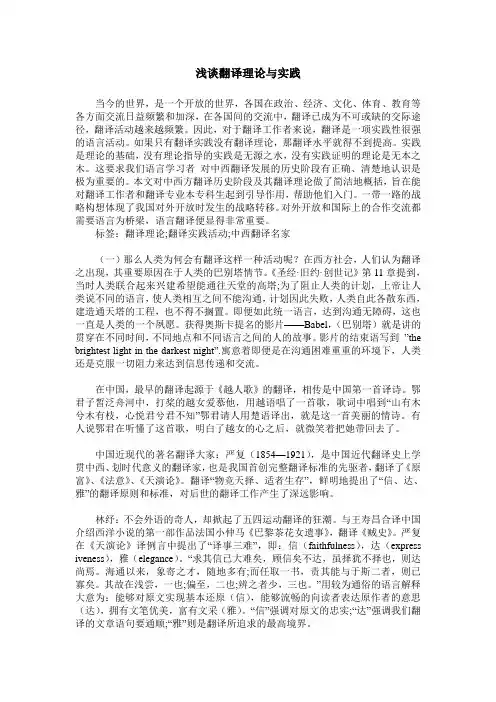
浅谈翻译理论与实践当今的世界,是一个开放的世界,各国在政治、经济、文化、体育、教育等各方面交流日益频繁和加深,在各国间的交流中,翻译已成为不可或缺的交际途径,翻译活动越来越频繁。
因此,对于翻译工作者来说,翻译是一项实践性很强的语言活动。
如果只有翻译实践没有翻译理论,那翻译水平就得不到提高。
实践是理论的基础,没有理论指导的实践是无源之水,没有实践证明的理论是无本之木。
这要求我们语言学习者对中西翻译发展的历史阶段有正确、清楚地认识是极为重要的。
本文对中西方翻译历史阶段及其翻译理论做了简洁地概括,旨在能对翻译工作者和翻译专业本专科生起到引导作用,帮助他们入门。
一带一路的战略构想体现了我国对外开放时发生的战略转移。
对外开放和国际上的合作交流都需要语言为桥梁,语言翻译便显得非常重要。
标签:翻译理论;翻译实践活动;中西翻译名家(一)那么人类为何会有翻译这样一种活动呢?在西方社会,人们认为翻译之出现,其重要原因在于人类的巴别塔情节。
《圣经·旧约·创世记》第11章提到,当时人类联合起来兴建希望能通往天堂的高塔;为了阻止人类的计划,上帝让人类说不同的语言,使人类相互之间不能沟通,计划因此失败,人类自此各散东西,建造通天塔的工程,也不得不搁置。
即便如此统一语言,达到沟通无障碍,这也一直是人类的一个夙愿。
获得奥斯卡提名的影片——Babel,(巴别塔)就是讲的贯穿在不同时间,不同地点和不同语言之间的人的故事。
影片的结束语写到”the brightest light in the darkest night”.寓意着即便是在沟通困难重重的环境下,人类还是克服一切阻力来达到信息传递和交流。
在中国,最早的翻译起源于《越人歌》的翻译,相传是中国第一首译诗。
鄂君子皙泛舟河中,打桨的越女爱慕他,用越语唱了一首歌,歌词中唱到“山有木兮木有枝,心悦君兮君不知”鄂君请人用楚语译出,就是这一首美丽的情诗。
有人说鄂君在听懂了这首歌,明白了越女的心之后,就微笑着把她带回去了。
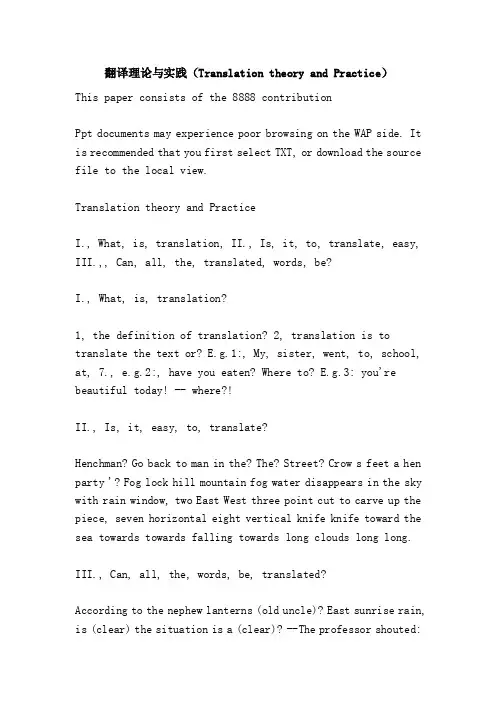
翻译理论与实践(Translation theory and Practice)This paper consists of the 8888 contributionPpt documents may experience poor browsing on the WAP side. It is recommended that you first select TXT, or download the source file to the local view.Translation theory and PracticeI., What, is, translation, II., Is, it, to, translate, easy, III.,, Can, all, the, translated, words, be?I., What, is, translation?1, the definition of translation? 2, translation is to translate the text or? E.g.1:, My, sister, went, to, school, at, 7., e.g.2:, have you eaten? Where to? E.g.3: you're beautiful today! -- where?!II., Is, it, easy, to, translate?Henchman? Go back to man in the? The? Street? Crow s feet a hen party '? Fog lock hill mountain fog water disappears in the sky with rain window, two East West three point cut to carve up the piece, seven horizontal eight vertical knife knife toward the sea towards towards falling towards long clouds long long.III., Can, all, the, words, be, translated?According to the nephew lanterns (old uncle)? East sunrise rain, is (clear) the situation is a (clear)? --The professor shouted:Gentlemen, order --The entire class yelled:! "" Beer! "--Why is the river very? Rich? --Because it has two banks.You can cage a swallow, but you can t swallow a "cage. --The secret is going to? Be exposed, and we ll look pretty silly. --You" already look pretty and silly. bathing on bikini? Girl, eyeing, boy, finds boy eyeing bikini on bathing girl.Chapter 1The definition of translation, the purpose of translation, the type of translation, the standard of translation, the process of translation, the conditions for translationDefinition of translationTranslation is the practice of language in which the content of another language is re expressed in one language. Feng Qinghua? Translation is a kind of language (i.e., primitive) information in another language (the target language) express, so that the readers can get the original thoughts expressed by the author, are roughly the same as the original readers feel. - Fan Zhongying, translation is the translator's re understanding of the same thing and the use of another text. - Qiao HaiqingDefinition of translationTranslation is "an interpretation of verbal signs by means of some other language Translation is." Jakobson? "The replacement of textual material in one language (SL) byequivalent textual material in another language (TL). Catford Translation is the replacement of? A representation of a text in one language by a representation of an equivalent text in a second language. HudsonThe purpose of translationA bridge of communication and communication between different languages and cultures.Types of translationIntra language translation (intralingual translation) an interpretation of verbal signs by means of other signs in the same language (interlingual translation) translation? An interpretation of verbal signs by means of some other language? Intersemiotic translation (intersemiotic translation) an interpretation of verbal signs by means of nonverbal signs systemChinese translation theoriesYan Fu: Xindaya translation - Three: xindaya. It is hard to ask for a letter. Take care of the letter and fail to reach it,Even if you do not translate it, you will also interpret it. ? Lu Xun: faith, Shun - a course to make it easy, one is to preserve the original charm. / / faith rather than fluency? Qu Qiubai: the notion of equivalence translation should be the original intention, exactly China introduced to readers, make readers get China concept concept equal to other language from the textto the reader. Contradiction: to reproduce the artistic conception the highest task of literary translation is to reproduce the artistic conception so that the target readers can enjoy the beauty as much as the original.Chinese translation theoriesLiu Zhongde: letter, reach, cut letter: believe in content: as long as it is cut: to adapt to style, Zhang today: true, good, beautiful, truth: truth, principle, good: ideological principles: Beauty: artistic principlesForeign translation theoriesTytler: 1. The translation should the same effect on give a complete transcript of the ideas of the original work. style and manner of 2. The writing should be of the same character as that of the original. translation should have all 3. The the ease of the original composition.Federov: on Translation should produce a translation version which may be read with as much pleasure as the original, and yet remain faithful to its spirit, sense and style. Nida: dynamic equivalence theory readers get responses, and feelings with the original readers read the original income roughly equal. Newmark: text centered theoryProcess of translationIt is generally believed that the original text is understood expression Nida: original text testAnalytical translationTarget textRestructureFour steps: analysis, translation, reconstruction, testTranslation, from, English, to, Chinese:1., The, days, run, into, weeks., the days go by, for a few weeks.2. It, s, all, Greek, to, me., the translation condition, I do not understand at all. Mandarin Chinese is better than3. Mary has? A clever tongue. Marie (glib glib). English language ability is better than4., You, can, never, tell., wide knowledge, no one can say.5., My, memory, failed, me, at, that, moment., I can't remember that moment.6., Your, name, obstinately, escapes, me., I can't remember your name.7., To, think, that, you, should, fail., I don't think you will fail. 8., Would, it, were, otherwise, if that's not the case. There was more mischief than harm in him. he is only mischievous, and no harm. 10., I, never, go, past, my, old, school, but,, think, of, our, headmaster.. Every time I pass my alma mater, I remember our headmaster. 11., The, book, is, beyond, me., I can't read this book. 12., There, is, nothing, like, leather, for, shoes., leather shoes are great. 13., It, is, too, recent, to, be, forgotten., fresh in memory.14., The, mountain, is, not, valuable, because, it, is, high.,mountain is precious, not at its height. The "This is the last place I where expected to meet you." did not expect to meet you here. 16., He, is, nothing, if, not, stubborn., he's a stubborn man. 17., I, was, not, a, little, surprised., I was shocked.18., He, can, do, it, if, any, one, can., only he can do it.19. You cannot make something out of nothing. one can't make bricks without straw. 20., I, can, t, bear, the, sight,, of, that, man.I can't stand seeing that man.Similar sentences1. He had made a box., he has made a box. He had a box made., he told people to make a box.2. Foolishly he spoke. he was so foolish to speak. He spoke foolishly. he talks very stupid.3. Quite properly he was punished. he deserved to be punished. He was punished quite properly., he was properly punished.4., We, asked, him, to, speak, from, his, experience., we ask him to talk about it based on his experience. We asked him to speak about his experiences. we asked him to talk about his experience.Similar sentences5. He is behind time. he's late. He, is, behind, the, times., he's behind the times.6. His success is out of question. his success is beyond doubt. His, success, is, out, of, the, question, he's never going to be successful.7., They, went, to, sea., they're going to besailors. They, went, to, the, sea., they went to the beach. 8., It, has, been, raining, continually, for, two, days., rain, intermittent two days. It has, been, raining, continuously, for,, two, days rain continued for two days.Similar sentences9., He, has, no, more, than, ten, books., he has only ten books. He has not more than ten books., he has ten books at most.He is not a little afraid of it. he was very scared. He is not a bit afraid of it., he is not afraid at all. 11., I, didn, t, go, because, I, was, afraid., I am not afraid to go. I, didn, t, go, because, I, to., was, afraid, I did not go, because I dare not go. 12. She kept the house., she watches over the house. She kept house. her home.Similar sentences13., This, is, no, place, for, me, to, go., this is not whereI should go. There, is, no, place, for, me, to, go, I have nowhere to go. 14. I, had, a, good, talk, to, him, yesterday., I gave him a good dressing down yesterday. I had a good talk with him yesterday. I had a really good time talking to him yesterday. 15., Tom, escaped, prison., Tom escaped the jail. Tom, escaped, from, prison., Tom, jailbreak. 16., Is, there, any, difficulty, in, this? Do you have any difficulty with this? Is, there, some, difficulty, in, this? It's a bit difficult, isn't it?Similar sentencesWe are sure that man is mortal. we are sure that man will always die. We, are, sure, that, man, is, dead., we are sure the man is dead. 18., We, hired, the, boat, by, the, hour.. We ship by hour. We hired, the, boat, for, an, hour., we rented an hour boat.Similar sentences19., I, did, not, notice, him., I didn't notice him. I, took, no, notice, of, him., I don't care about him. 20., Happily, he, did, not, die., thankfully he did not die. He did not die happily., he died uneasy.The second chapter is semantic translationFirst, the choice of meaning in the understanding of polysemy (polysemy)The translation of runRun, a, car, run, shop, run, oil, run, message, a, fever, run, a, computer, run, run, a, meeting, run,, chickens, run, a, arms, advertisement, run, anHead translation10. He arranged his speech under five heads. his speech is divided into five parts. 11., We, have, thirty, head, of, cattle.We have thirty cows. 12., Heads, or, tails? Heads or tails? 13., Where, is, the, head? Where is the toilet?The translation of head:1. head of the English Department, director of the English Department of2. head of the government head of the bed, head of government3.4. head of the staircase a of the needle at the top of the stairs5. head6. He was badly wounded in a the head. he was badly wounded in the head.7. He has a good head for maths. he has a lot of mathematical talent.8., You, should, use, your, head., you should use your head.9. The, dinner, cost, US, five, dollars, a, head., the meal cost us 5 yuan each.The translation of I. poor:1. The, cloth, is, poor, in, quality., this cloth is of poor quality.2. The, water, is, poor, in, oxygen., this water is anoxic.3. Her first concert had a poor audience., her first concert, with very few listeners.4. This, to, her, was, a, poor, consolation., this comfort does not work for her.5. In my poor opinion, you should let her go. in my humble opinion, you should let her go. Boat. She was a poor sailor and always went to bed immediately on on getting the she has seasickness problems, so always go to bed on board.The translation of II. runThe He will not be running in the next election., he is not ready to run for the next election. 2., The, train, is, not, running, today., that train is off today. 3. The film began to run. filmat the. 4. His face was running with sweat. he Sweat streamed down the face. 5., It, was, such, a, ran., hot, day, that, the, butter, the weather was so hot that the butter melted. 6., The, road, runs, north., this road extends north. The "The rumor runs that he is going to resign." is rumoured that he is going to resign. 8., The, monsoon, had, six, weeks, more, to, run., the rainy season will last six weeks.The translation of II. run9., The, car, repair, will, run, you, at, least, two, hundred., repair, at least you spend two hundred yuan. 10. The play ran for only a week in that theatre.. The play was only staged for a week in that theater. 11., Potatoes, are, running, large, this, year., potatoes grow a lot this year. 12., A, freezer, doesn, run., t, cost, much, to, the use of the refrigerator is not very expensive.The translation of III. liveShe needs to find somewhere to live. she needs to find a place to live. 2., Where, do, these, plates, live? Where are these dishes? 3., Spiders, can, live, for, several, days, without, food., spiders can live without food for a few days. 4., We, saw, a, real, rattlesnake, live! We saw a live rattlesnake.The translation of III. live5. The club has live music most nights., the club has live music most nights.6. The show is going on live., the show is being broadcast live.7., Pollution, is, still, very, much, a, live,issue. pollution is still a very interesting issue at the moment.8., This, is, a, live, and, interesting, book., this is a lively and interesting book.The translation of IV. like1., He, likes, mathematics, more, physics., than, he prefers mathematics to physics.2., Bananas, don, t, like, me., I ate a banana and my stomach was upset. (bananas do not fit my stomach.) Three它的味道像芒果。